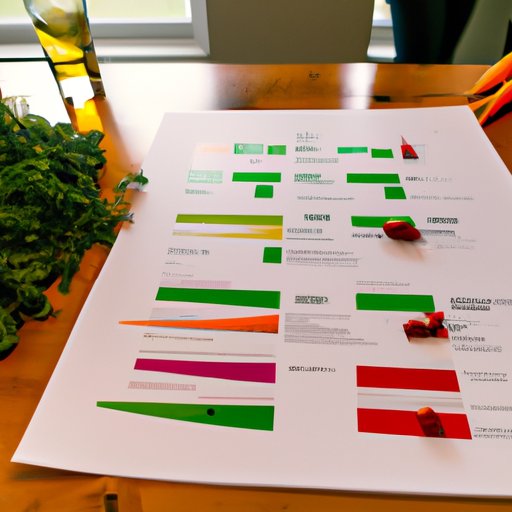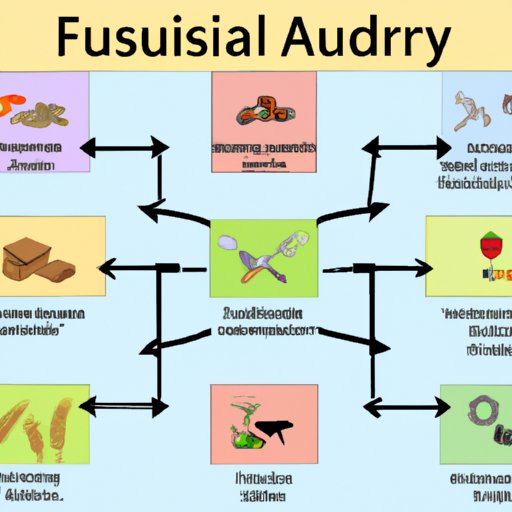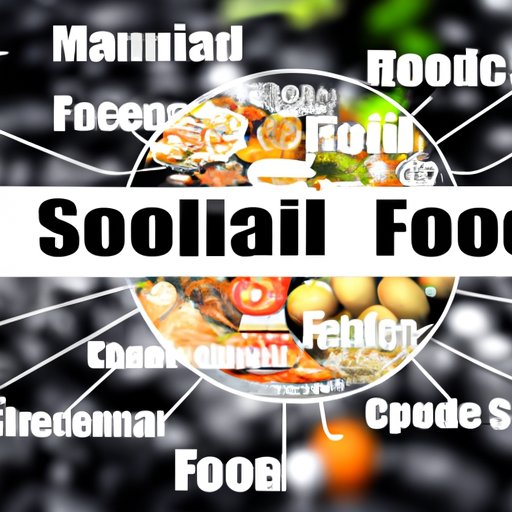Introduction
The food supply chain is the system of production, processing, distribution, retail, and consumption of food. It is a complex network that involves farmers, processors, distributors, retailers, and consumers. The goal of the food supply chain is to ensure that food products are produced, distributed, and consumed in a safe and efficient manner.

Analyzing the Flow of Food from Farm to Table
To better understand how the food supply chain works, it is important to analyze the flow of food from farm to table. This process begins with agricultural production, which involves growing crops, raising livestock, and harvesting food products. Once these products are produced, they must be processed and packaged for distribution. From here, the products are shipped to retailers where they can be purchased by consumers. Finally, the products are consumed by individuals or used in foodservice operations.

Exploring the Different Links in the Food Supply Chain
The food supply chain consists of several distinct links, each with its own unique role and responsibilities. These include:
Agriculture
Agricultural production is the first link in the food supply chain. Farmers and producers are responsible for growing crops, raising livestock, and harvesting food products. They also provide inputs such as fertilizers, pesticides, and other supplies necessary for successful farming.
Processing
Once food products are harvested, they must be processed and packaged for distribution. This includes cleaning and sorting the products, as well as preserving them for long-term storage. Processing also involves adding preservatives, flavorings, and other ingredients to improve the quality and shelf life of the product.
Distribution
Distribution is the next link in the food supply chain. Distributors are responsible for transporting food products from the processor to the retailer. They also handle the storage, packaging, and delivery of the products. This ensures that the products remain fresh and arrive at their destination intact.
Retail
Retailers are the final link in the food supply chain. They are responsible for selling food products to consumers. This includes setting prices, stocking shelves, and providing customer service. Retailers also play an important role in promoting food products, educating customers, and creating demand for certain products.
Consumption
Consumers are the ultimate link in the food supply chain. They purchase food products from retailers and use them for their own consumption. Consumers also play an important role in influencing food trends and shaping the food industry.

Examining the Role of Agriculture and Distribution in the Food Supply Chain
Farmers and producers are the foundation of the food supply chain. Without them, there would be no food products to distribute and consume. They are responsible for growing and harvesting food products, as well as providing inputs such as fertilizers and pesticides. Without them, food production would grind to a halt.
Distributors are also essential to the food supply chain. They ensure that food products are transported safely and efficiently from the processor to the retailer. They are also responsible for storing and packaging the products, as well as delivering them to their destination. Without them, food products would not reach the consumer in a timely manner.
Researching the Impact of Logistics on the Food Supply Chain
Logistics plays a critical role in the food supply chain. It encompasses transportation, storage, and packaging, all of which are essential for the successful delivery of food products from farm to table. Transportation involves moving food products from one location to another. This includes shipping products via truck, train, boat, or plane. Storage involves keeping food products in a cool, dry place to ensure that they remain fresh and safe for consumption. Packaging is also essential for protecting food products during transportation and storage.
Understanding the Interconnected Nature of the Global Food Supply Chain
The global food supply chain is highly interconnected. Trade agreements between countries can influence the flow of food products across international borders. In addition, economic factors such as rising fuel costs or currency exchange rates can have a significant impact on the cost of food products. Furthermore, technological advances such as GPS tracking, automated warehouses, and robotic harvesting can help to streamline the food supply chain and make it more efficient.
Conclusion
The food supply chain is a complex network of production, processing, distribution, retail, and consumption. It is essential for ensuring that food products are produced, distributed, and consumed in a safe and efficient manner. Understanding the different links in the food supply chain, their roles, and the impact of logistics can help to ensure that the food supply chain runs smoothly.
The interconnected nature of the global food supply chain means that trade agreements, economic factors, and technological advances can all have an effect on the flow of food products. By understanding these factors, businesses, governments, and consumers can work together to create a more efficient, sustainable food supply chain.
(Note: Is this article not meeting your expectations? Do you have knowledge or insights to share? Unlock new opportunities and expand your reach by joining our authors team. Click Registration to join us and share your expertise with our readers.)
